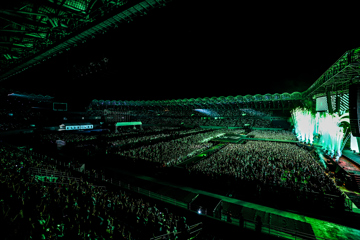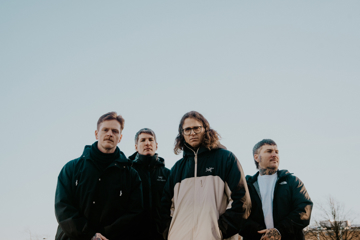'Grounded In Memories': Historic Brisbane Live Music Venue Closes Without Warning
With the news that Lefty's Old Time Music Hall has closed without warning, Lauren Baxter takes a trip down memory lane with Dr John Willsteed of Xero and The Go-Betweens to revisit the venue's history.

Photo by Lauren Baxter.
The historic Caxton Street venue Lefty’s Old Time Music Hall, also known as Baroona Hall, has closed without warning.
Plastered with ‘For Lease’ signs and deleting its website and Facebook page, the sudden closure is surrounded by allegations that the venue owes a large amount of money.
The Courier Mail, who broke the story earlier in the week, reports the venue allegedly owes more than $170,000 to creditors including musicians, security guards and consultants.
Located at 15 Caxton Street, the building is listed both for sale and for lease on the RE/MAX website.
 Lefty's Old Time Music Hall. Photo by Lauren Baxter.
Lefty's Old Time Music Hall. Photo by Lauren Baxter.
“Set in a tightly held and established location with direct access to the CBD and major arterials making this one of the hottest and most sought after inner city locations,” the listing reads.
RE/MAX real estate agent Geoff Esdale confirmed to The Music that the venue had been put on the market.
Fielding dozens of calls, Esdale says the majority of parties, including some from within the music industry, were interested in leasing the venue. Without knowing potential leasers’ intentions at this stage, he believes they “recognise how iconic [the building] is” and thinks “it won’t be changed drastically”.
Baroona Hall was constructed in 1884 by Richard Gailey for the United Brothers Lodge of the Order of Oddfellows. Used to manufacture clothes and military uniforms during World War I, it became known as Baroona Hall in 1928 and was a centre of local Labor Party activity. The hall was an important live music venue in the late ‘70s and '80s hosting punk gigs by the likes of The Leftovers, The Survivors, Xero and Razar, before it became strip club The Velvet Cigar and finally Lefty’s Old Time Music Hall in 2014.
“It was one of a number of halls that were really fantastically convenient to the inner-city,” Dr John Willsteed, of Xero and The Go-Betweens fame, now a member of Halfway and senior lecturer at QUT, tells The Music.
In a time where the Bjelke-Petersen Government was slashing funding and being “anti-youth, anti-alternative, and well anti-minority let’s put it that way”, Willsteed says there was “a lot of fundraising constantly going on”.
“Baroona Hall was really useful because it was central but also because it belonged, I think at the time, to the Labor Party and so they were friendly as far as renting it out to troublemakers,” he shares.
“It was a great hall, it was a really good size. Not very residential in the immediate vicinity. There were a couple of pubs nearby, people lived out the back and stuff, but you could make a bit of noise quite happily. It's a beautiful old hall and it still has elements of that in it but they're well disguised. When it became Lefty's or The Velvet Cigar or whatever it was before that, it really got a fairly significant kind of makeover but when we used to play there it was an empty room with a stage and we used to have to hire a PA and charge a bit to get in. It was a small scene where everybody knew everybody else so it was a pretty friendly social experience going to Baroona Hall.”
Willsteed played the venue a number of times with Zero/Xero and says the band “were given the opportunity on a couple of occasions to really kind of take the hall into our own hands”.
“It was colourful and wild and very, very DIY and playful in nature."
“We hired PAs, we hired bands that we really loved and were friends, we dressed up the hall and spent a lot of time thinking about how we could design these nights,” he says. “We would create a theme and those themes were about like kicking back against the government but also about playfulness and lightness and having a good time.
“I know we had a checkered evening there - I suppose we were inspired a bit by 2 Tone the record label - so we covered the hall inside with black and white bits of cardboard so it all looked checkered and everyone wore checkered clothes or black and white clothes. It was really great. On one particular evening there was a big caricature of Bjelke-Peterson by a local artist called Terry Murphy, and local guitarist Colin Bloxsom burst through it. It was two metres by three metres and he took his guitar and leapt through it onto the stage.
“We also had buckets of paint on strings from way up in the mezzanine right up the very back and these little paint tins were on ropes and they sent them down onto the stage and they burst onto the portrait and spread paint everywhere.
“It was colourful and wild and very, very DIY and playful in nature. It was really important for us as young people to have a space where we could play and when I say play I don't just mean play music but really have a playtime because being out on the street was so horrible and suburbia was so foul and debilitating so we needed to create fun for ourselves.”
During the ‘70s and ‘80s under the Bjelke-Peterson Government, Brisbane became notorious for knocking down old buildings. With this in mind, Willsteed recognises the importance of keeping Baroona Hall as a community-focussed building moreso than a live music venue. The hall is currently heritage listed.
“Our building heritage is always under threat in Brisbane and Baroona Hall had history long before it was a music venue,” Willsteed shares.
"Memories are triggered by the building and once the building is gone then those memories stop being triggered and it just becomes a story and disappears into the well of stories."
“As a community centre, as a place where people can go - a bit like Ahepa Hall in West End say which is right in the middle of the shops - it was important as a music venue but it was also important as a culture venue. Where people would meet and dance clubs would happen or there would be political meetings where people would discuss the issues of the day.
“So I think as a centre for community it's incredibly important and the buildings themselves are really important because they're visual triggers. Seeing them triggers the memory. [It was] part of a number of generation's contribution to Caxton Street. Memories are triggered by the building and once the building is gone then those memories stop being triggered and it just becomes a story and disappears into the well of stories. But to actually have the physical structure there, especially if it's still available for the community to use, it means that you can continue to build on that story.
“It's really important to glue our generations together in a time when there's a lot of, I hate to use this word, disruption to the way the generations talk to one another and how we construct the narrative of our own sub-cultural history. I don't want to sound like an academic wanker but I think this stuff is really important and the buildings are really important as a way of keeping us grounded in the memories of how our culture was made."







